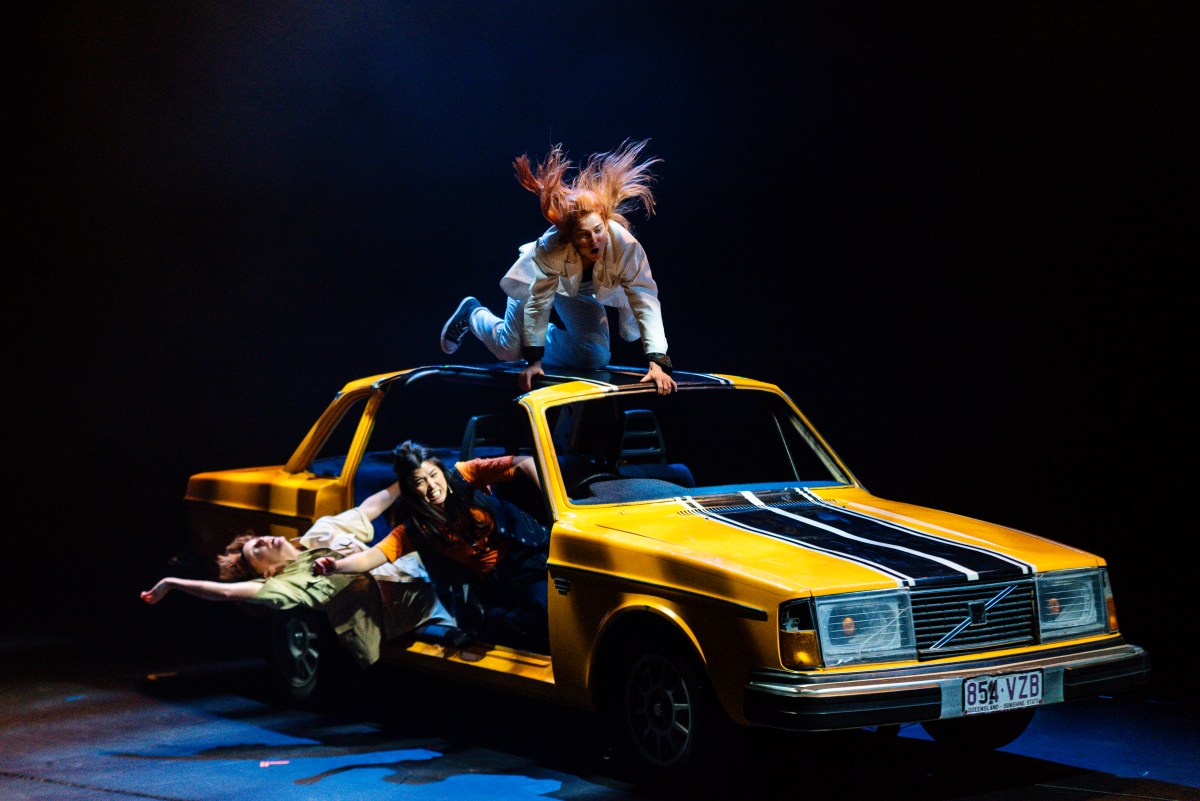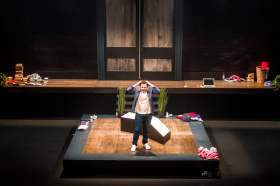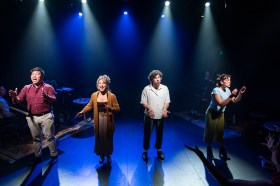The 1970s are often celebrated as an era of liberation and progress in Australia; but the underlying power dynamics of capitalism and sexism (not to mention racism) remained intact, especially in the entertainment industry. Lower-paid workers, women and people of colour were exploited; producers, directors and stars abused their power.
These contradictions are explored in Stunt Double, the latest offering from The Farm, a collaborative dance-theatre/contemporary performance company based on the Gold Coast. Company members Gavin Webber (writer, performer), Grayson Millwood (performer), Kate Harman (performer) and Chloe Ogilvie (lighting designer) developed the show in conversation with stunt performers about their experiences in the film industry.
The loose narrative framework is set on the shoot of a 70s Ozploitation film called Don’t Wake The Dark (an obvious allusion to Wake In Fright). Patrick Paterson (Webber) is a safari-suited action hero past his prime; sharing the screen with him (and barely tolerating his off-screen advances) is emerging star Maureen O’Sullivan (Harman). Meanwhile their stunt doubles (David Carberry and Alex Kay) do most of the work in the action sequences – although Paterson and O’Sullivan become increasingly competitive with them, insist on doing more of their own stunts, and eventually become locked in rivalry with their counterparts.
Other characters include the film’s manipulative director (Millwood – though on the night I saw the show his role was played by Matt Cornell), an eager beaver cameraman who is also the show’s announcer (normally played by Cornell, who on this occasion was replaced by Nathan Kell) and an exasperated assistant director (AD) (Ngoc Phan), doing her best to keep things on schedule. Other crew members and extras are played by audience volunteers, who are given instructions by the AD during the show, which adds an extra layer of comedy and spontaneity, as well as underlining (and to some extent subverting) the hierarchies typically operative during a film shoot.
The “on-set” scenes are wildly entertaining and have an appropriately B-movie feel. A fight scene in an outback pub (with the audience volunteers as extras) involves elaborate stunts and mid-shot substitutions between Paterson and his double. An attack on a group of picnickers by a pack of mutant dingoes (all played by the audience volunteers) leads to one of the dingoes (played by Paterson’s double) mauling O’Sullivan’s character before being viciously beaten to death by Paterson with a cricket bat.
Other scenes use a more abstract contemporary dance movement vocabulary and have a more surreal quality reminiscent of David Lynch, heightened by Ogilvie’s noirish lighting and ominous music by sound designer and composer Luke Smiles (in contrast with the bright film lights, adrenaline-fuelled Oz rock classics and exaggerated sound effects that accompany the fight scenes). This layer of the show explores the uncanny aspect of doubling and doppelgängers; a haunting sequence involves multiple reduplications of O’Sullivan and her double by audience volunteers wearing similar red dresses and wigs.
The two layers of the show merge in a nightmarish and thrilling climactic action sequence (recalling Quentin Tarantino’s Death Proof) that involves two of the characters in a stripped-back car driving headlong through the desert (an illusion created by the lighting and sound design), while the rest of cast (all wearing safari suits) hurl themselves at the vehicle and attack the driver and passenger.
This sequence culminates in a shocking “accidental” death on-set, which is effectively “covered up” by an abruptly descending red curtain. After an awards ceremony in front of the curtain in which the movie wins Best Film (with of course no mention of the stunt performers), the death tableau is re-revealed by a final Kabuki drop.
Webber shines (if that’s the right word) as the grotesque Paterson; the rest of the cast are not all equally skilled, but that hardly matters, as the show relies primarily on movement and image-making. Tyler Hill’s generic costumes and minimalist interactive film set design do their job effectively; sporadic video snippets from an awkward post-production interview with Paterson, O’Sullivan and the film director reveal in close-up the power dynamics and tensions we witness emerging on-set.
Read: Dance Review: Coalescing Towards, State Theatre Centre of WA, Perth Festival
Stunt Double is not simply a celebration or spoof of the Ozploitation genre (though it is undeniably both of those things), but a Swiftian satire on the entertainment industry and the dark truths that are normally concealed behind the curtain of celebrity and glamour. It also shines a light on the (mostly uncredited) work of stunt performers, and the level of exploitation and risk that (like most low-wage workers and women in the industry) they’re forced to endure. And, finally, it points to the enduring contradictions and unfulfilled promises of the 1970s that still haunt us today.
Stunt Double Studio Underground, State Theatre of WA
Created by The Farm: (Gavin Webber, Grayson Millwood, Kate Harman, Chloe Ogilvie)
Script: Gavin Webber
Set and Costume Designer: Tyler Hill
Sound Designer and Composer: Luke Smiles
Additional Composition: Johannes Malfatti
Lighting Designer: Chloe Ogilvie
Assistant Lighting Designer: Briana Clark
Stunt Consultants: Marco Sinigaglia and Carly Rees
Film Consultants: Mick Angus & Mark Wareham
Scenographer: Zoë Atkinson
Production Manager: Harrison Grindle
Stage Manager: Casey Norton
Produced by Performing Lines
Cast: Nat Kell, Kate Harman, Gavin Webber, Alex Kay, David Carberry, Ngoc Phan, Matt Cornell
Stunt Double was performed from 15-18 February at Perth Festival. It is touring to HOTA on the Gold Coast, followed by Canberra Theatre Centre.





